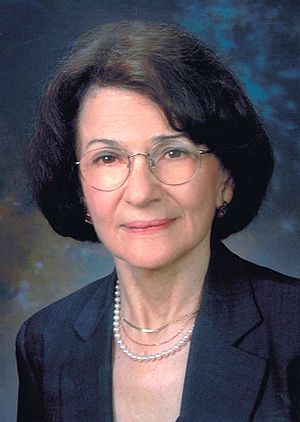Patricia Goldman-Rakic facts for kids
Quick facts for kids
Patricia Goldman-Rakic (née Shoer)
|
|
|---|---|
 |
|
| Born | April 22, 1937 Salem, Massachusetts, United States
|
| Died | July 31, 2003 Hamden, Connecticut, United States
|
| Nationality | American |
| Alma mater | Vassar, UCLA |
| Awards |
List
Source: Yale News: |
| Scientific career | |
| Fields | neurobiology |
| Institutions | Yale University |
| Doctoral advisor | Wendell Jeffrey |
Patricia Goldman-Rakic (pronounced rə-KEESH; born Shoer) was an important American scientist. She was a professor at Yale University School of Medicine and studied the brain. She was a pioneer in understanding the prefrontal cortex and working memory. The prefrontal cortex is the front part of your brain, important for thinking and planning. Working memory is like your brain's scratchpad, holding information you need right now.
Contents
Early Life and Education
Patricia Shoer was born on April 22, 1937, in Salem, Massachusetts. Her parents were immigrants from Latvia and Russia. She grew up in Peabody, Massachusetts.
She went to Vassar and earned her first degree in neurobiology in 1959. She then got her doctorate degree in experimental developmental psychology from the University of California at Los Angeles in 1963.
After finishing her studies, Patricia Goldman-Rakic worked at the National Institute of Mental Health. She later became the Chief of Developmental Neurobiology. In 1979, she moved to Yale School of Medicine. She stayed there until her death. At Yale, she was a professor of neuroscience.
Brain Research and Discoveries
Patricia Goldman-Rakic was the first scientist to map out the connections in the prefrontal cortex. She also showed how this part of the brain is linked to working memory. Before her work, many scientists thought it was too hard to study the higher thinking functions of the prefrontal cortex.
Her research proved that you could use scientific methods to understand these complex brain areas. She helped scientists learn more about how our brains think and remember. Her work also helped us understand brain disorders better. These include conditions like schizophrenia, Alzheimer's, ADHD, cerebral palsy, Parkinson's disease, and dementia.
Goldman-Rakic used many different scientific methods in her research. She combined biochemistry, electrophysiology, and other techniques. She was also the first to study how dopamine affects the prefrontal cortex. Dopamine is a chemical in the brain. This research is very important for understanding conditions like schizophrenia, ADHD, and Parkinson's disease.
She wrote over 300 scientific articles and helped edit three books. She also helped start the Cerebral Cortex Journal with her husband, Dr. Pasko Rakic. Early in her career, she studied how the brain can repair itself when it's still developing.
Personal Life
Patricia Goldman-Rakic had two sisters, including her identical twin, Dr. Ruth Rappaport. She was married to Dr. Lawrence Goldman. In 1979, she married Pasko Rakic, who was also a neuroscientist.
Legacy and Recognition
On July 29, 2003, Patricia Goldman-Rakic was hit by a car in Hamden, Connecticut. She passed away two days later on July 31 at Yale-New Haven Hospital. She is buried in Grove Street Cemetery.
To honor her memory, the Goldman-Rakic Prize for Outstanding Achievement in Cognitive Neuroscience was created. This award celebrates scientists who make important discoveries about the brain's frontal lobe. The prize is given every year to scientists who have a big impact on the study of how we think.
Awards and Honors
- George Peabody Award (1954)
- National Institute of Mental Health grantee (1980–2000)
- W. Alden Spencer Award, Columbia University (1982)
- Krieg Cortical Discoverer Award, Cajal Club (1989)
- Inducted National Academy of Sciences (1990)
- Fyssen Foundation Prize in Neuroscience (1990)
- Merit Award of NIMH (1990)
- Lieber Prize, National Alliance for Research on Schizophrenia and Depression (1991)
- Inducted American Academy of Arts and Sciences (1991)
- Robert J. and Claire Pasarow Foundation Medical Research Award (1993)
- John P. McGovern Award in Behavioral Sciences (American Association for the Advancement of Science) (1993)
- Karl Lashley Award, American Philosophical Society (1996)
- Ariëns Kappers Medal, Royal Netherlands Academy of Arts and Sciences (1996)
- Honorary doctorate, Utrecht University (2000)
- Ralph Gerard Prize, Society for Neuroscience (2002)
- Gold Medal for Distinguished Scientific Contributions, American Psychological Association (2002)
- Honorary degree, St. Andrews College of the University of Edinburgh (2003)
- Inducted to the Connecticut Women’s Hall of Fame, Science & Health category (2008)
Goldman-Rakic was also the President of the Society for Neuroscience from 1989-1990. She was also a fellow of The American Psychological Association.
See also
 In Spanish: Patricia Goldman-Rakic para niños
In Spanish: Patricia Goldman-Rakic para niños

